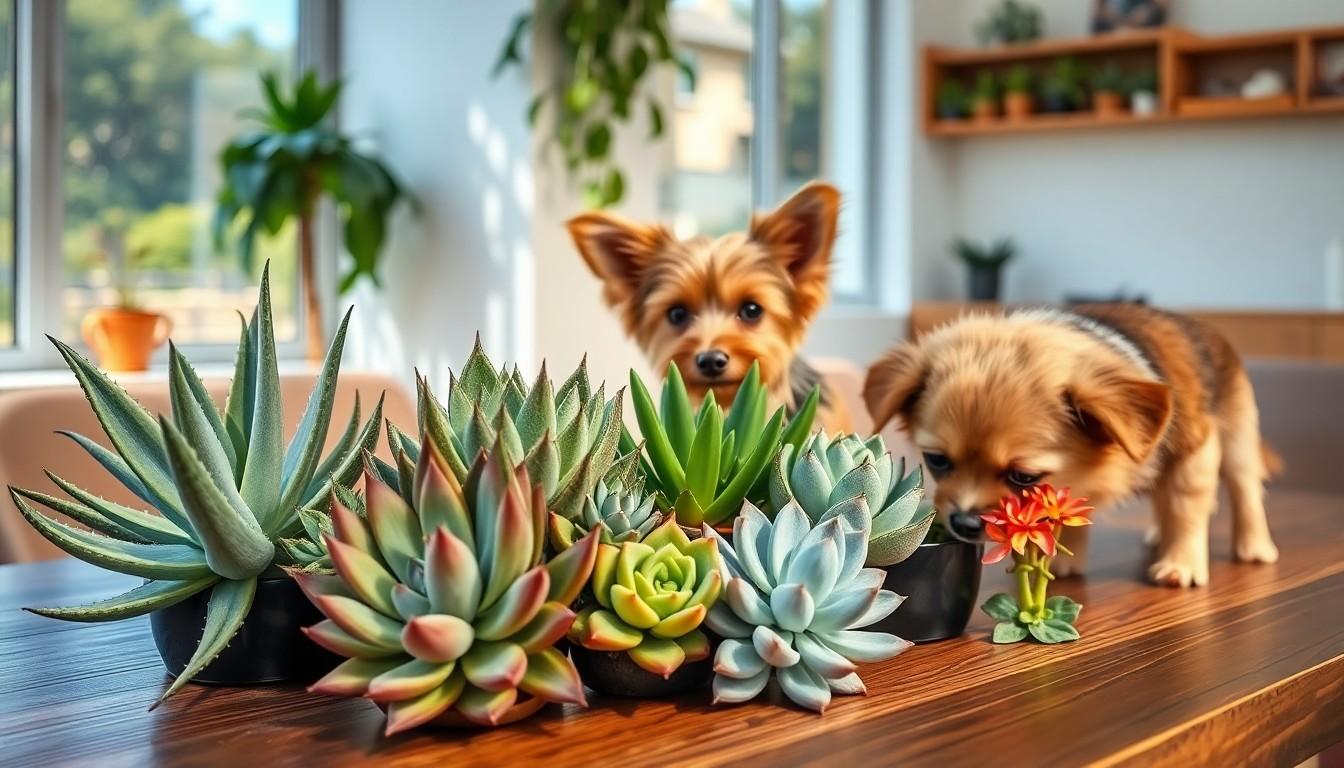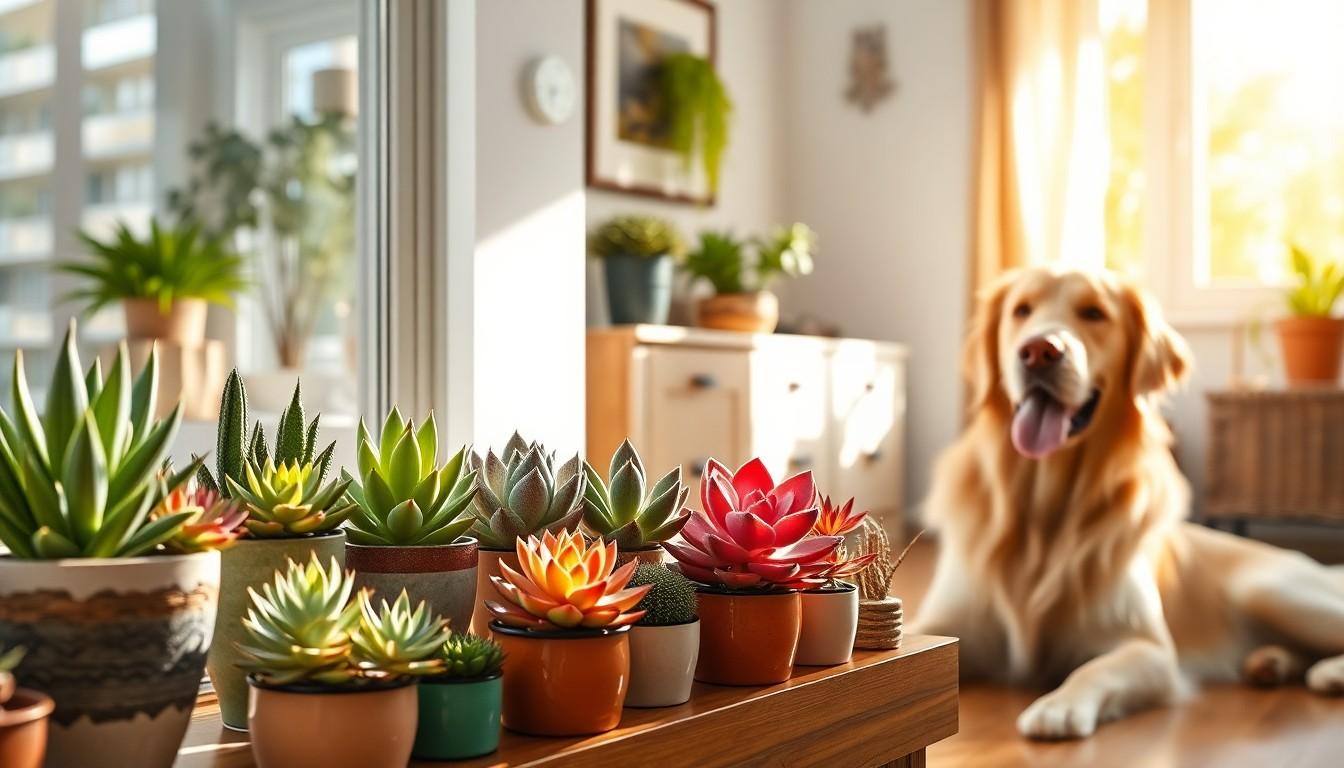When it comes to home decor, succulents are the ultimate low-maintenance darlings. They add a splash of green and a dash of personality to any space. But before you start your succulent collection, there’s a tiny detail you might want to consider—some of these charming plants can spell trouble for your furry friends. Yes, it’s true! While your dog might think they’re just another chew toy, certain succulents can pack a serious punch.
Overview of Succulents
Succulents are popular houseplants due to their unique appearances and minimal care requirements. These plants store water in their leaves, stems, and roots, enabling them to survive in arid environments. Different varieties feature vibrant colors, interesting shapes, and textures, appealing to many plant enthusiasts.
Certain succulents possess toxic properties, making them dangerous for pets, especially dogs. For example, plants like Aloe Vera, which is commonly known for its healing properties in humans, can cause gastrointestinal upset in dogs when ingested. Another example is the Jade Plant, which might lead to depression or lethargy in pets.
Understanding which succulents are safe and which are toxic is essential for pet owners. Identifying the specific varieties in one’s home can prevent accidental ingestion. Keeping plants out of reach can reduce risks significantly.
Many common household succulents can cause adverse reactions if a dog consumes them. Symptoms may include vomiting, diarrhea, and in some cases, serious health issues. Caution is particularly important for dogs that are curious or prone to chewing on plants.
Researching plant toxicity is crucial for choosing safe succulents. Consult reliable sources, including veterinary guidance or toxic plant databases, to determine which succulents are safe for households with pets. Prioritizing pet safety while enjoying the beauty of succulents is vital.
Common Succulents Toxic to Dogs

Some succulents pose risks to dogs when ingested. Awareness of these plants is essential for pet owners.
Aloe Vera
Aloe Vera contains compounds that can be harmful to dogs. Ingesting this succulent may lead to symptoms like vomiting and diarrhea. The plant’s saponins and anthraquinones contribute to gastrointestinal distress. If dogs consume Aloe Vera, they may exhibit signs of lethargy and decreased appetite. Keeping Aloe Vera out of reach prevents instances of accidental ingestion.
Jade Plant
Jade Plant is another succulent that can be toxic to dogs. This plant can cause symptoms such as slowed heart rate and vomiting. Its toxicity stems from components like terpenoids and various other chemical compounds. Observing symptoms early ensures timely veterinary care. By securing Jade Plants in safe locations, pet owners can avoid potential health issues.
Kalanchoe
Kalanchoe is known for its vibrant flowers, but it’s toxic to dogs. Ingestion of this succulent can result in serious health concerns, including gastrointestinal upset and cardiac issues. Responsible pet ownership includes knowing the risks associated with Kalanchoe. Keeping this plant out of a dog’s reach minimizes risk. Remaining vigilant about plant safety creates a healthier environment for pets.
Identifying Poisonous Succulents
Identifying toxic succulents is crucial for dog owners. Knowledge of visual traits helps in distinguishing safe plants from harmful ones.
Visual Characteristics
Aloe Vera features thick, fleshy leaves with serrated edges. Jade Plants possess oval-shaped, glossy green leaves that grow on woody stems. Kalanchoe displays clusters of small flowers atop its broad leaves, often seen in vibrant colors. Some toxic succulents appear deceptively benign, blending well in home interiors. Observing unusual markings or textures on leaves can also indicate toxicity. Leaf shape, growth pattern, and color provide essential hints that aid in identification. Regular examination of plant characteristics ensures awareness of potentially poisonous varieties in the home.
Common Misconceptions
Many people assume all succulents are safe for pets, which isn’t true. Some believe Aloe Vera has only beneficial properties, ignoring its harmful effects on dogs. It’s a common misconception that toxic plants aren’t found in everyday settings. Family members may overlook Jade Plant’s toxicity, as its appeal often overshadows its dangers. An understanding that some succulents can be harmful despite their beauty fosters vigilance among pet owners. Awareness of toxic plants encourages responsible choices when selecting succulents for home decor. Avoiding these misconceptions is vital to ensuring pets remain safe from various plant hazards.
Safe Alternatives to Succulents
Safety remains a priority for pet owners when selecting plants. Numerous alternatives offer visual appeal without posing risks to dogs.
Pet-Friendly Plants
Spider plants stand out as non-toxic options. They thrive in various lighting conditions and require minimal care. Bamboo palms add a lush tropical touch and provide air-purifying benefits. Another great choice includes Boston ferns, which prefer humidity and indirect sunlight. Parlor palms also serve as safe indoor plants while enhancing decor with their elegant fronds. Consider pothos as an easy-to-care-for option; however, it’s essential to keep it out of reach, as it can cause mild gastrointestinal upset. All these plants offer beauty while ensuring a safe environment for pets.
Care Tips for Dog Owners
Positioning plants out of dogs’ reach remains crucial. Sturdy shelving or hanging baskets often keeps plants safe from curious pets. Choosing larger pots can deter dogs from knocking them over. Opt for plants that thrive in the home’s natural environment, ensuring they grow healthily while staying safe. Regularly monitoring plant condition helps catch any signs of distress or pest infestations. Always maintain awareness of your dog’s behavior, adjusting plant placements if needed. With these strategies in place, creating a pet-friendly space full of greenery becomes an enjoyable reality.
Conclusion
Understanding the risks associated with succulents is essential for pet owners. While these plants can add beauty to any home they’re not all safe for dogs. It’s crucial to identify and keep toxic varieties out of reach.
By choosing non-toxic alternatives and being vigilant about plant safety, pet owners can enjoy the aesthetic benefits of succulents without compromising their dog’s health. Responsible pet ownership involves making informed choices that create a safe living environment. Keeping pets safe while enjoying the charm of greenery is entirely possible with the right knowledge and precautions.

